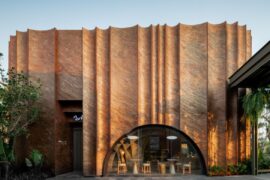The hotel industry is being disrupted, we talk with Marriott International’s Toni Stoeckl on the value of customer experience, sustainability and wellness to stay one step ahead in the hospitality space.

September 20th, 2019
We caught up with Toni Stoeckl, Global Brand Leader, Lifestyle Brands, Marriott International during his recent visit to Australia. Stoeckl plays an essential role in defining the direction of the global marketing strategy of the brand. In his interview, Stoeckl speaks about the emergence of experience-driven travel and the need for hotels to adapt to these changing trends to foster sustained growth.
Toni Stoeckl: I’m particularly passionate about experience-driven travel. That means building an experience that resonates with today’s travellers – their lifestyles and their personal interests, and that leaves them with stories to tell and share with their family and friends. For example, at Moxy Hotels – the first of which is coming to Australia in 2021 – the bar doubles as reception (yes, guests check-in over a coffee or cocktail) and a place for locals and travellers to hang. It sets a playful, social tone for the stay.
Next – sustainability. There’s no sign of this slowing any time soon. In fact, according to Booking.com, 87 per cent of global travellers say they want to travel sustainably. Finally, there’s wellness which is impacting the travel industry in a different way. In all honesty, we’re still trying to calibrate how wellbeing comes to life for different audiences. But some of the ways that we’re doing it in Australia, like at the new Element Melbourne Richmond (designed by Rothelowman), for example, is by offering healthy snacks 24/7 through a grab-and-go-pantry, and a bikes-to-borrow program. It all stems from the idea that travel shouldn’t need to disrupt our routines.
We recognise that travel is changing. People are travelling in groups (sometimes with multiple generations of family) and they’re looking for spaces to accommodate this. We’re using technology more and more to change the way that we facilitate transactions with our guests.
From an environmental design perspective, we’re putting a big focus on creating shared, communal spaces in our properties that allow guests and locals to come together. For example, the lobby space at Element Melbourne Richmond has been designed to look more like a living room, complete with soothing natural tones, comfortable lounge chairs, a fireplace and books to read. This gives our guests a space they can relax and socialise outside their room.
The innovation lab is an onsite replica of the different rooms our guests stay in every day. This is where designers and architects work to create the hotel room of the future. It’s through these that we test new and emerging trends and technologies. Some that we’ve tested recently include mobile check-in, which allows guests to use their phone as a guest room key. Then there are portable wine carts, where guests can simply insert their room key and dispense their favourite wine or even customisable meals with guests’ favourite foods and ingredients, prepared specifically by the hotel chef.
Lifestyle hotels, in particular, appeal to younger travellers, who, according to Tourism Research Australia, account for 45 per cent of international spend. So, for us, it’s about uncovering what it is the next generation of travellers want. Take Gen Z travellers, for example. One of the insights that we uncovered recently was that this segment is looking to collect experiences because they want to be perceived as interesting when they share their experiences on social media or with family and friends back home.
In my opinion, there are two things that hotels can do to foster sustained growth and success. The first is to create a memorable experience. Experiences are considered a form of currency in their own right. But you only remember things that are new, fun and interesting, which leads me to my second point – create a clear point of difference.
As we like to say, it’s about being something to someone, not something to everyone. For lifestyle brands in particular, the sweet spot lays in allowing guests to travel how they want. So, a fun, playful traveller will enjoy the little touchpoints at a Moxy hotel that allow them to connect with others and share their stay in a cheeky way. Travellers who are more wellbeing-driven for example will enjoy the convenience of being able to stick to their routines while on the road when staying with Element hotels.
Brands also need to create experiences that encourage repeat visitation. For example, the ‘Live at Aloft’ brand program sees a constantly changing roster of emerging artists performing at Aloft Hotels around the world, so guests and locals are encouraged to come back and see new acts again and again.
–
Catch Indesign #79 our Hospitality special issue for more insights into transformative design ideas for hospitality spaces. Subscribe to our weekly newsletter for more design inspo.
A searchable and comprehensive guide for specifying leading products and their suppliers
Keep up to date with the latest and greatest from our industry BFF's!

In this candid interview, the culinary mastermind behind Singapore’s Nouri and Appetite talks about food as an act of human connection that transcends borders and accolades, the crucial role of technology in preserving its unifying power, and finding a kindred spirit in Gaggenau’s reverence for tradition and relentless pursuit of innovation.

BLANCOCULINA-S II Sensor promotes water efficiency and reduces waste, representing a leap forward in faucet technology.

Designed by FARM, the newly opened Hafary House prioritises customer engagement through an immersive and sensory shopping experience. Here’s what you can expect.

IDIN Architects creates another spectacular project following its win in The Social Space category at the 2024 INDE.Awards.
The internet never sleeps! Here's the stuff you might have missed

IDIN Architects creates another spectacular project following its win in The Social Space category at the 2024 INDE.Awards.

In this New Zealand workplace design by Wingates, Anthony Harper were “keen to evolve their working environment as the world evolves as well.”